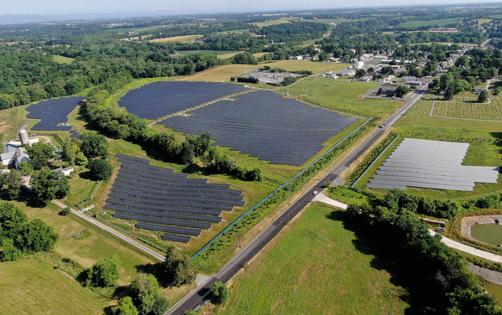University of Maryland professor sorts through myths about long-term implications of solar farms
Published in Science & Technology News
BALTIMORE — The Maryland Department of the Environment is pushing for 50% of the state’s electricity generation by 2030 to come from renewable energy resources, such as solar.
Solar projects in Maryland include utility-scale solar, which are larger in scale and generate power directly to the grid; community solar, which are smaller-scale systems that can power a neighborhood; and residential solar, which are panels that are placed on individual homes, mostly for one family’s needs.
Elizabeth Thilmany, a University of Maryland faculty specialist in agriculture law, found in her research that 1,965 acres of land in the state are used in utility-scale solar. That’s a total of 19 projects as of May 2024; of those acres, 1,757 were previously farmland.
“There’s been an uptick in the amount of utility-scale solar projects that have gone in the [Certificate of Public Convenience and Necessity] queue,” Thilmany said. “Ten years ago, we were seeing a few trickle in, and now we’re seeing at least 15 or 20 for the year.”
Community solar projects have also risen. Since 2015, when state legislation established a community solar pilot program, 139 have been built and are operational, according to the Maryland Public Service Commission’s most-up-to-date data, from June 30, 2024.
Gov. Wes Moore signed a bill in May that aims to spur more community solar projects. The law prevents local governments from adopting zoning laws that restrict the construction or operation of solar energy projects if they meet all required criteria. Under the legislation, local jurisdictions are also required to expedite the review and approval of these projects. Many saw this as a response to Carroll County officials’ 2023 ban on solar projects built on farmland.
As Maryland pushes for more solar, some worry about the unknown long-term implications of this green energy.
Paul Goeringer, principal faculty specialist focusing on agriculture law at the University of Maryland, said research on solar in the state is still very new.
“We don’t know what that exact impact is yet,” Goeringer said. “We just haven’t had the resources to be able to pull it off.”
Through U.S. Department of Agriculture grants, his team is working on researching where and how solar projects are popping up across the state. Its work has focused on leasing resources for landowners and ways to bolster their knowledge about options for their land.
The projects Thilmany has mapped are heavily centered on the Eastern Shore because land there is flatter and has more consistent sunlight, and companies would have to clear fewer trees, she said. Only 12 counties have utility-scale solar projects.
“There’s an inverse relationship between community and utility,” Thilmany said. ” [In] the counties that don’t have as much wide escaping land available, you’re going to see more community.”
While the implications of solar are still unknown, misconceptions on the industry continue to surge — especially for community solar projects where thousands of panels are being placed next to, and sometimes within, residential neighborhoods. Farmland tends to be a prime target for solar projects, resulting in panic in communities that depend on agriculture.
Through focus groups and surveys, researchers are seeking to answer questions about the growing industry of solar energy. Here are some of the biggest misconceptions, according to experts:
Solar panels are releasing chemicals into the soil
Research shows that the materials in solar panels are sealed so that the metals inside don’t hurt the soil; there is no “leaching of metals” contaminating the soil, said Mitchell Pavao-Zuckerman, associate professor of urban ecosystems and sustainably built environments at the University of Maryland.
Despite some concerns that freak storms or hail could potentially break the metal giants, causing them to release harmful chemicals, Pavao-Zuckerman said there’s nothing to release.
“It’s not like they have a bunch of metals just sort of free floating — it’s not like a thermometer that’s full of mercury,” he said.
Even panels made 10 to 15 years ago were designed not to release chemicals into the ground, he said. The way panels are built, the only way to get to the metals is if the panels break and erode over time. There are no liquid metals “waiting to get out” if a panel cracks.
Chemicals from the solar panels release into groundwater
The materials used for solar panels are sealed, limiting possible water contamination. It’s comparable to water hitting a rooftop, Pavao-Zuckerman said. The water isn’t contaminated; it has nowhere to go to get infiltrated or absorbed. Unless the panels are broken, there’s “not a strong risk to groundwater or drinking water pollution.”
The panels can impact the way water moves through a site. The runoff from the panels can cause water to pool, different from standard patterns of rainfall. This can have an indirect impact on the productivity of the plants underneath the panels, Pavao-Zuckerman said. The piling of the soil water can slightly reduce the carbon stored in the ground.
“It’s almost like a shift — you get more of it where the water hits and less of it where the water doesn’t,” Pavao-Zuckerman said.
The saturation of runoff requires the same stormwater management practices that are seen in more urban areas, he added, such as basins or rain gardens. Early studies do not show a huge impact on soil health or quality, he said, but it is an open area for research.
Solar panels are heating the ground
One of the first studies Pavao-Zuckerman did in Arizona tried to answer whether an industrial solar park would increase the temperature in a residential neighborhood.
The study found that there was less of an effect the further the temperature sensors got from the panel concentration. Inside the panel space, temperatures were regularly 3 to 4 degrees Celsius higher.
“It’s almost sort of like an urban heat island effect that’s generated by those panels,” Pavao-Zuckerman said. “That was in a desert system. We don’t really know necessarily what that’s going to do here, where the energetics are a little bit different.”
Agrivoltaics was introduced as a way to mitigate this heating effect. The presence of plants cools the environment around the panels. Maintaining grass or pollinator habitats like flower meadows could produce enough water to reduce the heat islands, he said.
This remains an open research question, he added.
Farmland cannot be used for agriculture farming after solar panels are removed
The tech used for solar projects is not invasive enough to have an impact on the soil, Pavao-Zuckerman said, but there could still be a long-term impact on the microenvironments.
Tyler Hough, director of government relations for the Maryland Farm Bureau, believes that once the prime and productive soils are removed, they’re “not a resource that we can get back.”
“Those soils, when they’re gone, they’re gone,” Hough said. “There’s no getting them back. And we haven’t seen a solar array or a solar lease come to full term yet.”
The way solar panels are placed could lead to increases or decreases of rainfall in some areas, reducing soil organic matter, Pavao-Zuckerman said. Changes in water patterns created by the solar panels could lead to erosion or gullies — ravines caused by water.
Research on this is just beginning, Pavao-Zuckerman said.
-----------
©2025 The Baltimore Sun. Visit at baltimoresun.com. Distributed by Tribune Content Agency, LLC.







Comments